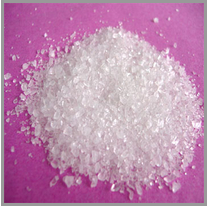Lactic Acid
Lactic Acid, CH3CH(OH)COOH, is a white water-soluble solid, that dissolves into a clear liquid. A chiral organic compound, lactic acid has 2 optical isomers: L-(+)-lactic acid, aka: S-lactic acid or L-latic acid, and D-(-)-lactic acid aka: R-lactic acid. Lactic acid is used in a wide variety of industries including: animal feed, food, personal care, pharmaceutical, and plastics.
Food:
In the food industry, lactic acid can be found in meats, baking materials, beverages, dairy, and as an ingredient for various types of food additives. Some lactic acid food additives have been used to enhance flavor, increase appetite, add nutritive value, and prolong the shelf life of products.
Additional Notes:
* Anaerobic Metabolism & Muscle Fatigue: Lactic acid is produced by your body when strenuous physical activity causes your muscles to demands more oxygen than the body can supply at a given time. Pyruvate is produced via glycolysis (breaking down sugar) when muscles cannot break down carbohydrates due to the lack of oxygen. This pyruvate is converted to lactic acid, which is converted to lactate. This lactate is cleared up rapidly: lactate in the blood goes to the liver, where it is converted into glucose &/ amino acids, some is converted into energy by muscles, and some is lost in sweat.
In conclusion, muscle fatigue is not cause by lactic acid, but by other factors such as increased H ions, which increase acidity, and muscle tear/damage (which set into motion other events leading to soreness). Read more at: www.scientificamerican.com, www.livestrong.com, and emedicine.medscape.com.
* Of the two forms of lactate (L & D), L-lactate is the only form produced in human metabolism, and is the only form that is human-digestible.
| CAS | Product | Chem | Purity | Product Code | Quote |
|---|---|---|---|---|---|
| 50-21-5 | Lactic Acid | C3H6O3 Linear: CH3CH(OH)COOH | 88% | AC-02-X | Quote; |
| Chemistry | TDS | SDS |
|---|---|---|
| CH3CH(OH)COOH | Request TDS | Request SDS |
Industrial/Application_tags:
Animal Feed, Food, Pharma, Plastic, Personal Care, Laboratory






